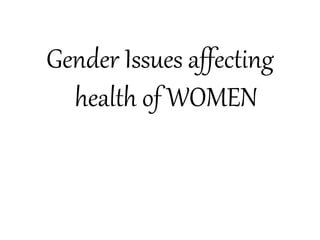
Gender issue effect on health of women
- 1. Gender Issues affecting health of WOMEN
- 2. Definition “Gender refers to the socially constructed characteristics of women and men- such as the norms, roles and relationships that exist between them” WHO
- 3. Gender means the state of being male or female or a transgender referring to the roles the person play in the society based on the sex of the person or personal identification of one's own gender.
- 4. Distinction between Gender and Sex • In ordinary speech, “sex” and “gender” are often used interchangeably. • As discussed, “gender” refers to the state of being male or female or a transgender defined by the social roles and individual’s identification whereas, “sex” is classified on the basis of their reproductive organs and functions.
- 6. Measures of Gender Equality • There are over 300 different indicators used to measure the gender equality, as well as number of important indices. • The most prominent index of gender equality used are: 1. Human Development Index (HDI) by United Nations Development Program 2. Gender Equality Index by Social Watch 3. Gender Empowerment Measure (GEM) by United Nations Development Program 4. Global Gender Gap Index by World Economic Forum 5. Social Institutions and Gender Index by Organization for Economic Co-operation and Development (OECD) Center Source: https://en.wikipedia.org/wiki/Measures_of_gender_equality
- 7. • India ranks 131 in 2017 among 188 countries by UNDP in terms of the Human Development Index (HDI) – The Human Development Index (HDI) is a statistical tool used to measure a country's overall achievement in its social and economic dimensions. – The social and economic dimensions of a country are based on the life expectancy, Education and Per capita income. Source: http://hdr.undp.org/en/composite/HDI
- 8. • India is ranked 125 of 159 countries in the Gender Inequality Index (GII) 2016 UNDP report. –The Gender Inequality Index (GII) is an index for measurement of gender disparity done by UNDP based on three dimensions • Reproductive health • Empowerment • Labor market participation Source: http://hdr.undp.org/en/content/gender-inequality-index-gii
- 9. • According to Social Watch 2012 report, India ranks 145 out of 168 in Gender Equality Index. • The Gender Equity Index (GEI) measures the gap between women and men in – Education, – Economy, and – Political empowerment. Source: http://www.socialwatch.org
- 10. • According to World Economic Forum’s report in 2016, India ranks 87 out of 144 countries on Global Gender Gap Index (GGGI). • The GGGI is measured on – Economic participation and opportunity – Education – Health and survival – Political Empowerment Source: eports.weforum.org/global-gender-gap-report-2016/rankings/
- 11. • According to Organization for Economic Co- operation and Development (OECD) 2012 report, India ranks 96 of 102 non-OECD countries in the Social Institution and Gender • Key indicators for measuring SIG – Education – Health Status – Economic – Political Participation Source: http://www.oecd.org/dev/development- gender/theoecdsocialinstitutionsandgenderindex.htm
- 12. WHERE ARE WE NOW???? Some Important Indicators
- 13. Sl No Key Indicators Male Female 1 Education a. Literacy and Education (2011 Census) 82.14% 65.5% b. Population (female) age 6 years and above who ever attended school (%) (NFHS 4 2016) 68.8% c. Women with 10 or more years of schooling (%) (NFHS 4 2016) 35.7% 2. Health Status a. Life Expectancy at Birth 62.6 64.2 b. MMR (RGI (SRS) 2007-09, 2010-12) 178/ 100000 c. Mothers who had full antenatal care (%) (NFHS 4) 21%
- 14. Sl No Key Indicators Male Female 3 Woman Empowerment a. Currently married women who usually participate in household decisions (%) (NFHS 4 2016) 84% b. Parliament Seats 73.2% 26.8% c. Law Enforcement (Women Police) (Source: http://indianexpress.com dated: March 28,2017) 92.9% 7.1% 4 Economic a. Women who worked in the last 12 months who were paid in cash (%) (NFHS 4 2016) 24.6% b. Woman Labor Force Participation (Source: International Labour Organization, Global Employment Trends 2013: Recovering from a Second Jobs Dip) 28%
- 15. Key Issues affecting the health of Women in India
- 16. 1. Gender differences in Education Education is critical to social and economic development and has a profound impact on health of an individual. • Education is not wise attained by Indian women. Although literacy rates are increasing, female literacy rate lags behind the male literacy rate. • The Male literacy rate is 82.14% and Female literacy rate is 65.46% according to Census 2011. • An underlying factor for such low literacy rates are parents' "perceptions that education for girls are a waste of resources as their daughters would eventually live with their husbands’ families and they will not benefit directly from the education investment.
- 17. 2. Gender Differences in participation in public Health – Awareness about health problems and how to treat them • In developing countries, men seek treatment more frequently at formal health services, whereas women are more likely to self-treat or use alternative therapies. • The lower social status of women influences how society responds when they are affected by stigmatizing illnesses, such as HIV/AIDS, leprosy, tuberculosis, and mental illness.
- 18. 3. Gender differences in economic opportunities – Over 50% of Indian labour is employed in agriculture. A majority of rural men work as cultivators, while a majority of women work in livestock maintenance, egg and milk production. – There is wage inequality between men and women in India – The largest wage gap was in manual ploughing operations in 2009, where men were paid ₹ 103 per day, while women were paid ₹ 55 (WAGE RATES IN RURAL INDIA (2008-09) Labour Bureau, MINISTRY OF LABOUR & EMPLOYMENT, Govt of India (2010) –
- 19. 4. Gender differences in Political Participation